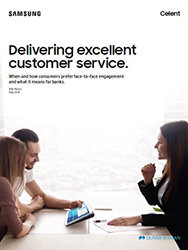How do you picture the future of banking? Is it a drive-through run by artificial intelligence? A multipurpose space where you can access banking technology while you shop or get coffee? Maybe you don’t picture a physical location at all, supposing instead that the future of banking is solely digital.
In fact, research from Celent suggests that physical branches will still play an important role into the foreseeable future — and banking technology will have to be updated to keep customers engaged. Just as retailers are incorporating technology to improve the customer experience, the bank of the future will leverage mobile devices and wearables to make in-branch banking more personalized, efficient, effective and — perhaps most importantly — more pleasurable.
So what exactly will the bank of the future look like?
The omnichannel effect
When it comes to customer experience, retail has set a new standard of omnichannel service. Today’s consumers expect to engage with brands seamlessly, whether they’re shopping or seeking service online, in store, over the phone or any combination thereof.
Now that this expectation has been set, there’s no putting the proverbial toothpaste back in the tube. Banks have the choice to either deliver personalized experiences that span all of their channels or become increasingly outdated.
The banking experience of 2030
Miriam is a 30-year-old customer of ABC Bank. She gets up for work in the morning and goes into the kitchen, where she can see on her Family Hub refrigerator that her savings budget is almost where it needs to be to start looking for a new home! She then asks the virtual assistant to send her a list of potential homes for sale to her mobile device, through ABC Bank’s mobile app.
On the train on the way to work, she scans the homes, sees one she likes and decides to request a mortgage from ABC Bank.
Unfortunately, even with the savings, she’s not approved for the amount she expected or the interest rate she wanted. ABC Bank messages Miriam to let her know they’re available if she wants to discuss the terms. She uses the app to makes an appointment at her local ABC Bank branch to discuss her credit-building options.
Creating Personalized Customer Experiences
Get your free guide to when, how and why consumers want face-to-face interaction with their banks. Download Now
As Miriam arrives at the branch office, her mobile phone automatically triggers a proximity beacon in the branch network, and a greeting screen inside displays a personalized welcome message. An employee also greets Miriam by name and helps her check in using a tablet. Miriam’s banker is notified on his smartwatch that Miriam has arrived to discuss credit-building solutions.
As Miriam’s banker finishes his conversation with another customer, the bank’s tablet Miriam is holding serves her with content about credit-building secured loans, based on her customer profile.
When the banker meets with Miriam, he explains how a secured loan works and, once Miriam is on board with the idea, helps her start her application on the tablet as they transition to his office. When they arrive in the office, the banker docks his device, finalizes the paperwork and helps Miriam set up automatic loan payments to complete the process. The banker also sets personal reminders to check in with Miriam after six months on the status of her credit score.
When Miriam is ready to apply for a mortgage again, all of her personal information will be automatically loaded so she won’t have to fill out the lengthy application a second time.
At the end of the day, Miriam arrives back home and sees that her connected devices are updated to match her new goals.
The branch is vital to the bank of the future
This process is more than convenient — it’s highly personalized. Miriam feels heard, supported and cared for in a situation that could have otherwise been detrimental to her relationship with ABC Bank.
With more than half of customers saying they still prefer the bank for investment advice, financial planning and opening new accounts — in other words, some of life’s biggest moments — customer relationships still live and die by the branch, and more specifically, the seamless omnichannel experience.
As Celent reported, “fixation on cost savings through transaction automation may provide a short-term return on investment, but it will not support the [branch’s] enduring strategic reason for being.” That reason for being is to ignite and constantly rekindle customers’ loyalty to the brand by surprising, supporting and impressing them during some of the most important moments of their lives.
This is the power that financial institutions have always had, and today’s banking technology makes it easier than ever to deliver. The branch will be alive, well and essential to the future of banking as long as people count on other people to help them through life’s biggest and most personal decisions.
Explore how Samsung’s banking technology improves engagement by mobilizing associates and connecting customers, or learn how bank branch associates can efficiently and effectively help customers using mobile technology.









